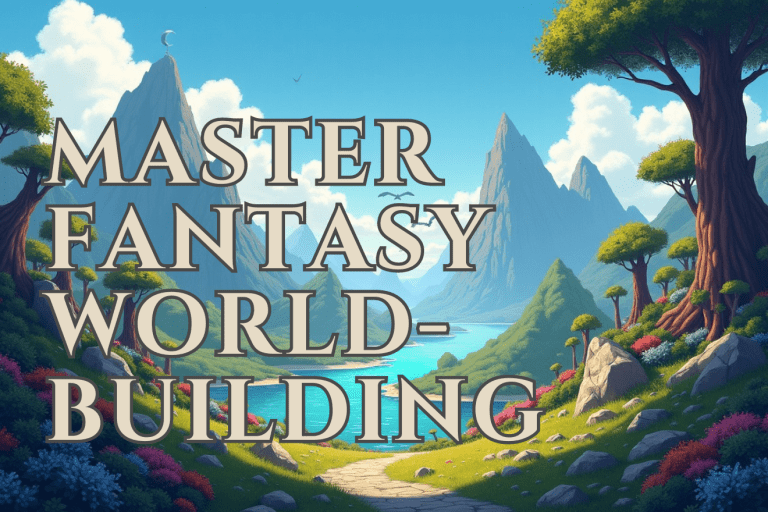World-Building 101: Crafting Unforgettable Settings
Imagine stepping into a world so vivid, so real, that you can almost feel the alien sun on your skin or hear the bustling of a steampunk marketplace. That’s the power of effective world-building! As Stephen King once said, “Description begins in the writer’s imagination, but should finish in the reader’s.” In 2024, world-building has become more crucial than ever for fiction writers. Did you know that 63% of readers say a well-developed fictional world is what keeps them coming back to their favorite authors? Let’s dive into the art of creating immersive settings that’ll have your readers begging for more!
Understanding the Foundations of World-Building
World-building is the process of creating a detailed and believable fictional universe. It’s essential for fiction writing because it adds depth and richness to your story. A well-crafted world can captivate readers and make them want to explore every corner of it.
- Elements of a Fictional World: Geography, culture, history, and societal structures are key components. Each adds layers of authenticity and makes the world feel lived-in.
- Impact on Reader Engagement: When readers connect with a world, they become more invested in the story. They’re drawn into the narrative, eager to see how characters interact with their environment.
Looking to dive deeper? Check out this amazing World-Building course on Udemy
Start with the Big Picture: Mapping Your World
Before diving into the details, start with the big picture. A physical map of your world can help you visualize the setting and plan your story.
- Creating Physical Maps: Whether hand-drawn or digital, maps help establish the scope and layout of your world. Consider the terrain, climate, and major landmarks.
- Determining Scale and Scope: Decide how large your world is. Is it a single city, a vast empire, or an entire planet? The scale will influence your story’s complexity.
- Unique Geographical Features: Incorporate features like mountain ranges, rivers, and deserts that can shape your plot. Geography can affect travel, trade, and even conflicts.
Developing Rich Cultures and Societies
Cultures and societies add depth to your world. They influence how characters think, behave, and interact.
- Creating Diverse Cultures: Think about the customs, traditions, and beliefs that define different groups in your world. Diversity makes your world feel real and vibrant.
- Cultural Customs and Taboos: Explore what’s considered acceptable or forbidden in your world. These elements can create conflict and drive the story forward.
- Social Structures and Political Systems: Decide how societies are organized. Who holds power? How do different classes or groups interact? This can add layers of intrigue and tension.
For a deeper dive into creating compelling cultures, explore this guide on world-building from MasterClass.
Crafting a Compelling History for Your World
A rich history adds context and meaning to your world. It explains how things came to be and influences current events in your story.
- Developing a Timeline: Create a timeline of significant events that have shaped your world. This can include wars, discoveries, and pivotal moments that impact your story.
- Legends and Folklore: Myths and legends add depth and mystery to your world. They can also serve as plot points or themes within your story.
- Weaving History into Your Storyline: Use historical elements to inform your plot. Characters might discover lost artifacts, uncover ancient secrets, or grapple with the consequences of past events.
Building Believable Ecosystems and Magic Systems
Ecosystems and, if applicable, magic systems, should be consistent and logical.
- Creating Unique Flora and Fauna: Design plants and animals that fit your world’s environment. Consider how they interact with each other and the inhabitants.
- Developing Magic Systems: If your world includes magic, establish clear rules. What are its limits? Who can use it? Consistency is key to maintaining believability.
- Balancing Realism and Fantasy: Even in a fantastical world, elements should make sense within the context of that world. This balance keeps readers immersed in the story.
Creating Languages and Naming Conventions
Languages and names add authenticity to your world.
- Developing Unique Languages: If your world has its own languages or dialects, create simple rules for how they work. Use them sparingly to avoid confusing readers.
- Naming Conventions: Create names that reflect your world’s cultures. Consistency in naming conventions helps readers remember and connect with characters and places.
- Do’s and Don’ts of Invented Languages: Don’t overwhelm readers with too much invented language. A few words or phrases can go a long way in adding flavor without confusing the narrative.
Bringing Your World to Life Through Sensory Details
Use all five senses to bring your world to life.
- Describing Your World with Senses: Don’t just describe what characters see. Include sounds, smells, textures, and even tastes to create a fully immersive experience.
- Creating Atmosphere and Mood: Sensory details can set the tone for scenes. A bustling marketplace might be loud and chaotic, while a hidden cave could be damp and eerie.
- Avoiding Info-Dumps: Introduce details gradually. Let readers discover the world through the characters’ experiences rather than overwhelming them with information.

Maintaining Consistency in Your World-Building
Consistency is crucial to avoid breaking the reader’s immersion.
- Creating and Maintaining a World Bible: A world bible is a document where you keep track of all the details about your world. This helps prevent contradictions and maintains consistency.
- Tracking Details: Use your world bible to track character names, places, cultural details, and historical events. This ensures continuity throughout your story.
- Gradual World Revelation: Reveal your world’s details slowly as the story progresses. This keeps readers engaged and curious.
Avoiding Common World-Building Pitfalls
World-building is an art, but it’s easy to fall into traps that can detract from your story.
- World vs. Characters and Plot: Don’t let your world overshadow your characters or plot. The story should always come first.
- Balancing Familiar and Unique Elements: While originality is important, including familiar elements helps ground readers in your world.
- Avoiding Stereotypes and Clichés: Be mindful of clichés and stereotypes. Strive for originality and depth in your world-building.
End of the World(-building Article)
Wow, what a journey through the art of world-building! We’ve explored everything from mapping your world to crafting its languages. Remember, the key to creating truly immersive settings is in the details and the passion you pour into them. As you embark on your world-building adventure, keep these tips in mind, but don’t forget to let your imagination run wild! After all, you’re not just writing a story – you’re crafting entire universes. So go forth and build worlds that will captivate readers for years to come. Who knows? Your fictional setting might just become the next Middle-earth or Hogwarts.
For more insights and tools on creating immersive settings, visit the BookMatchClub homepage.







